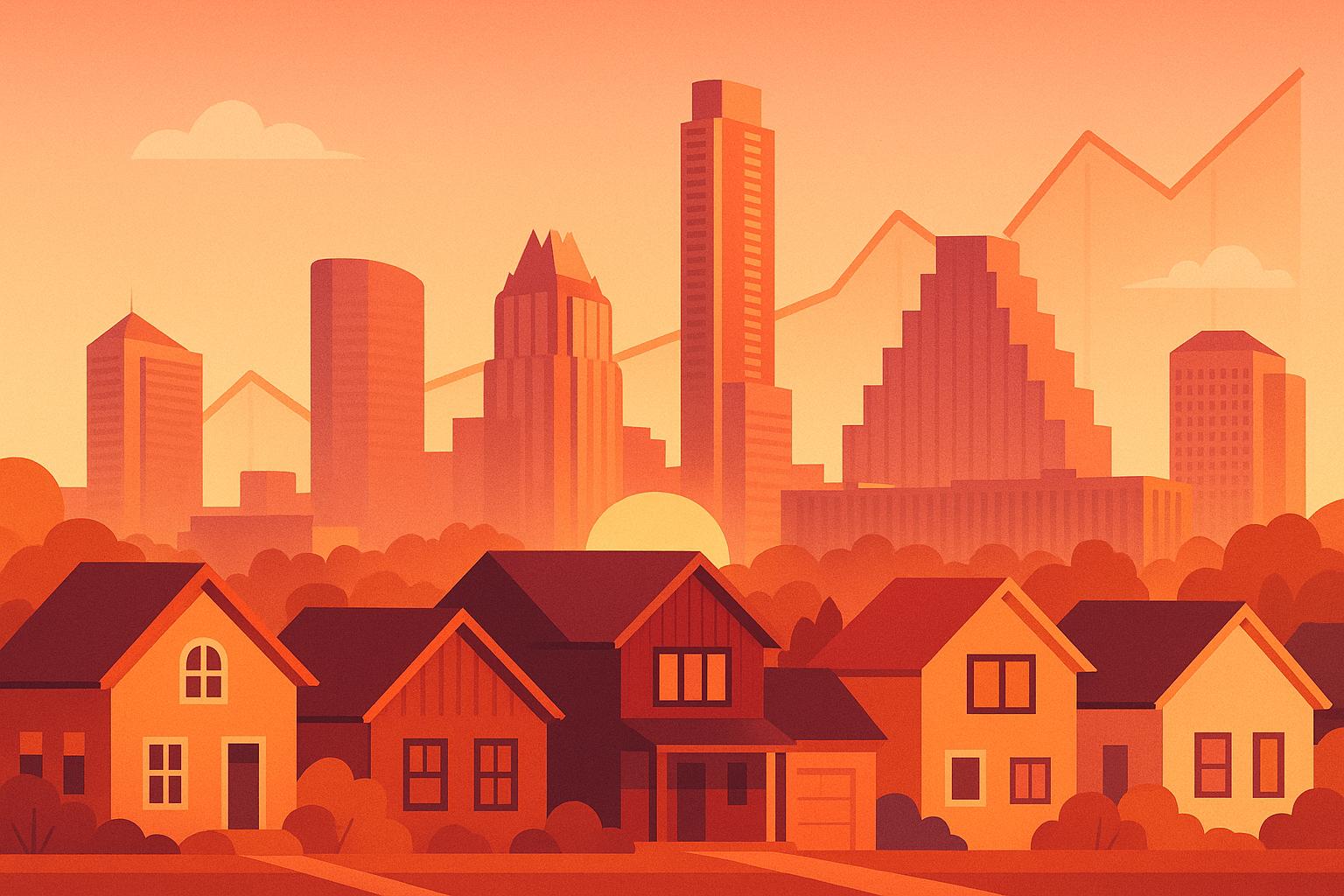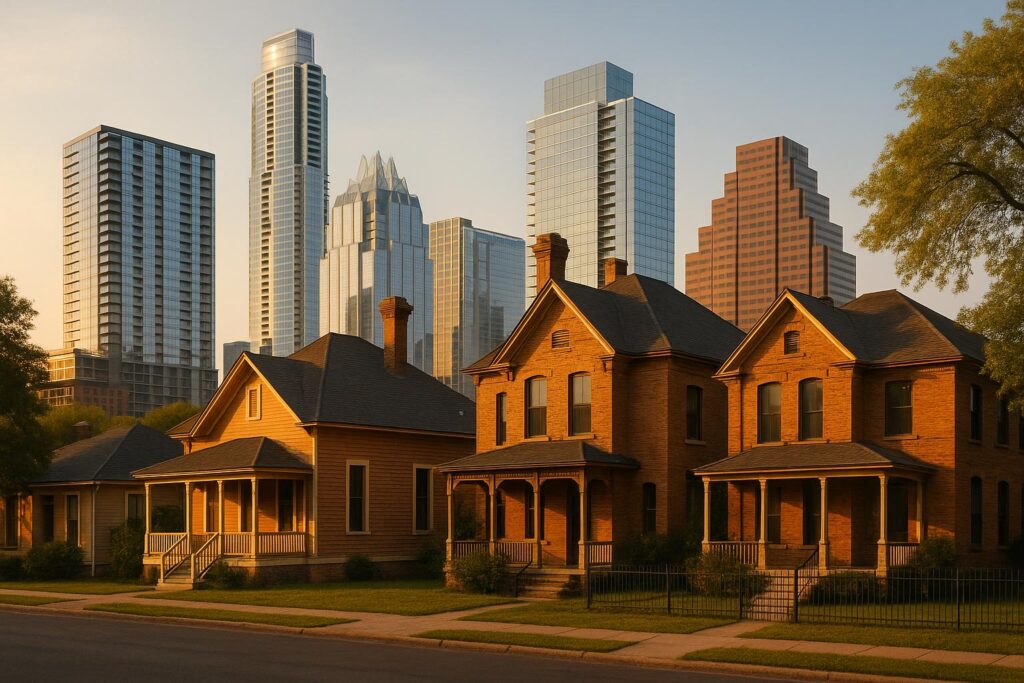-
2020–2022: Prices Soared
- Median home prices surged due to remote work migration, low mortgage rates, and limited housing supply.
- By mid-2022, prices peaked, with homes selling above asking prices.
-
2023–2024: Market Adjusted
- Prices began cooling off after the 2022 peak.
- Higher interest rates reduced buyer demand, leading to a more balanced market.
-
2025: Signs of Recovery
- Early 2025 shows stabilization with modest price increases and renewed buyer activity.
- New construction projects are helping improve housing availability.
Quick Fact: Median home prices in Austin have risen 33.6% since January 2020, despite the recent slowdown.
| Period | Market Phase | Key Trends |
|---|---|---|
| 2020–2022 | Rapid Growth | Sharp price hikes, low inventory |
| 2023–2024 | Adjustment | Prices leveled off, cautious buyers |
| Early 2025 | Recovery | Stabilization, modest price increases |
Austin’s housing market reflects a shifting post-pandemic landscape. Whether you’re buying, selling, or investing, understanding these trends is key to making informed decisions.
April 2025 Housing Market Report for Austin, Texas
Price Surge During 2020-2022
The Austin housing market experienced a sharp rise in home prices during the pandemic. This increase was driven by various market dynamics that emerged during this time.
Key Drivers of Price Growth
Several factors played a role in pushing prices higher:
| Factor | Effect on Market |
|---|---|
| Remote Work Migration | Tech workers relocating for cheaper housing increased demand. |
| Interest Rates | Historically low mortgage rates encouraged more buyers. |
| Housing Inventory | Limited availability created intense competition among buyers. |
| Population Growth | A growing local population further fueled housing demand. |
The combination of remote work flexibility, attractive mortgage rates, and a tight housing supply created the perfect conditions for rapid price increases.
2022 Price Peak
By mid-2022, single-family home prices in Austin hit all-time highs. Homes were selling quickly, often attracting multiple offers and exceeding their listing prices. This intense activity marked the peak of the market before the eventual adjustment.
Market Adjustment: 2023-2025
After the rapid growth from 2020 to 2022, Austin’s housing market shifted, impacting both home values and buyer behavior.
Price Drops Since 2022
Median home prices in Austin declined after hitting their peak in 2022. This adjustment followed the high demand seen during the pandemic, bringing more balance to the market.
Rising Interest Rates and Buying Power
As the Federal Reserve increased interest rates, mortgage costs rose, leading to higher monthly payments. This made it harder for some buyers to qualify for loans, creating a more cautious market environment.
Signs of Recovery in Early 2025
By early 2025, the market began showing improvement. Modest price increases, higher sales activity, quicker transactions, and renewed multiple-offer situations emerged. Additionally, new construction picked up. These trends suggest a healthier market, even with prices still higher than pre-pandemic levels. The Austin Local Team continues to track these developments and provide insights for buyers and sellers navigating this evolving landscape.
sbb-itb-4c99469
Price Changes: Pre-Pandemic vs. Now
Austin’s housing market has seen major shifts since January 2020, starting with a pandemic-driven surge, followed by a market correction.
2020 Starting Prices
Back in January 2020, the median price for a single-family home in Austin was $299,291.
Price Growth Since 2020
Median home prices have risen by 33.6% since January 2020. A few factors fueling this growth include:
| Factor | Influence on the Market |
|---|---|
| Job Market | Growth in industries like technology |
| Infrastructure Growth | Improved city amenities and services |
While prices have cooled from their peak, they remain well above pre-pandemic levels, highlighting Austin’s strong market dynamics. This trend offers valuable context for understanding future market projections.
Market Predictions and Trends
After a period of adjustment, the Austin housing market shows steady growth fueled by development and a rising population. Future opportunities align closely with past trends, signaling continued expansion.
2026 Price Outlook
A new $150 million skyscraper under construction downtown is expected to reshape Austin’s skyline by 2026. With ongoing investments in infrastructure, new buildings, economic growth, and a growing population, the market is poised for steady appreciation in the coming years. These factors highlight the importance of understanding geographic trends and addressing supply challenges.
Expanding Austin Neighborhoods
Downtown Austin remains the center of development, but up-and-coming neighborhoods are creating fresh opportunities for both residents and investors. For personalized insights into specific areas, reach out to the Austin Local Team.
Supply Challenges and Pricing Pressures
Even with increased construction, inventory shortages persist and may limit market growth. While the market showed strong recovery in early 2025, these shortages continue to pose challenges. Staying up-to-date on local real estate trends and new construction projects is essential for buyers and investors looking to navigate these conditions.
Summary and Market Impact
Austin’s real estate market in 2025 reflects the changes brought on by the post-pandemic era. After a period of rapid expansion followed by a slowdown, the market has now settled into a more balanced state, shaped by the lessons of recent years.
Higher interest rates have reduced buyers’ purchasing power. However, early signs of recovery in 2025 and a resurgence in construction projects highlight the market’s resilience. These changes present opportunities for buyers, sellers, and investors alike, though each group must adapt its strategies to the current conditions.
- For Buyers: The current market gives you more room to negotiate compared to the competitive frenzy of 2020–2022. Partnering with experienced local agents, such as those from the Austin Local Team, can help you find properties that align with your budget and have potential for future growth.
- For Sellers: Pricing your property strategically is crucial to maximizing returns in today’s high-valuation market. A professional market analysis can ensure your property remains competitive.
- For Investors: Austin’s steady population growth and ongoing infrastructure projects make it a strong choice for long-term investment. Focus on up-and-coming neighborhoods near new developments to capitalize on future growth.
Since 2020, the market has matured, rewarding those who make informed decisions. With continued expansion through new construction and development, having local expertise is more important than ever for navigating these market dynamics.
FAQs
Why did Austin home prices rise so sharply during the pandemic?
During the pandemic, Austin experienced a significant surge in home prices due to several key factors. Increased demand played a major role, as remote work allowed many people to relocate to Austin for its quality of life, tech-driven job market, and vibrant culture. At the same time, limited housing inventory created intense competition among buyers, driving prices higher. Additionally, historically low mortgage rates made homeownership more accessible, further fueling demand.
These factors combined to create a perfect storm, leading to a sharp rise in prices for single-family homes across the city. As the market adjusts post-pandemic, it’s crucial to stay informed about current trends to make well-informed real estate decisions in Austin.
How have rising interest rates impacted Austin home prices since 2022?
Rising interest rates since 2022 have played a significant role in shaping Austin’s housing market. Higher borrowing costs have made mortgages more expensive, which has led to a cooling effect on homebuyer demand. As a result, home price growth in Austin has slowed compared to the rapid increases seen during the pandemic.
While prices remain elevated compared to pre-pandemic levels, the market has become more balanced, offering opportunities for buyers to negotiate and for sellers to adjust expectations. For a deeper understanding of Austin’s housing trends, including yearly changes, exploring local data can provide valuable insights.
What is the outlook for Austin’s housing market, and which neighborhoods show the most potential for growth?
The future of Austin’s housing market looks promising, with steady demand driven by the city’s growing population and thriving job market. While specific trends can vary, many experts expect continued interest in areas offering a mix of affordability, amenities, and proximity to downtown.
Neighborhoods like East Austin, South Congress, and Mueller have been gaining attention for their vibrant communities and increasing property values. These areas are often highlighted for their unique character, walkability, and access to local businesses. However, it’s always a good idea to consult with a local real estate expert to get the most up-to-date insights tailored to your needs.





